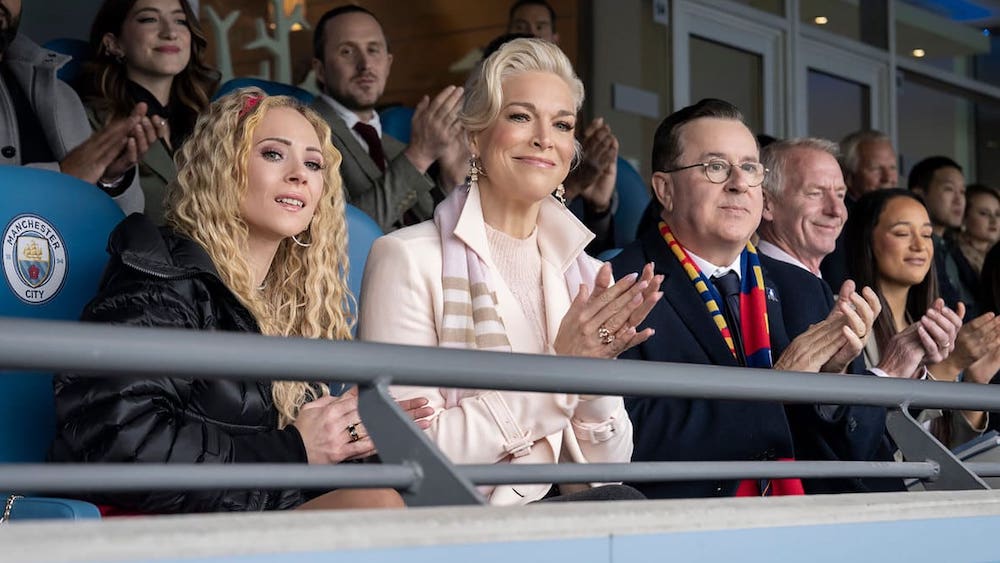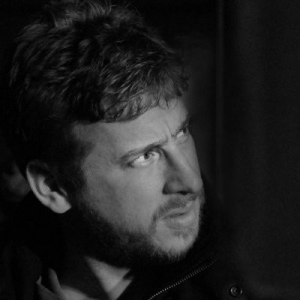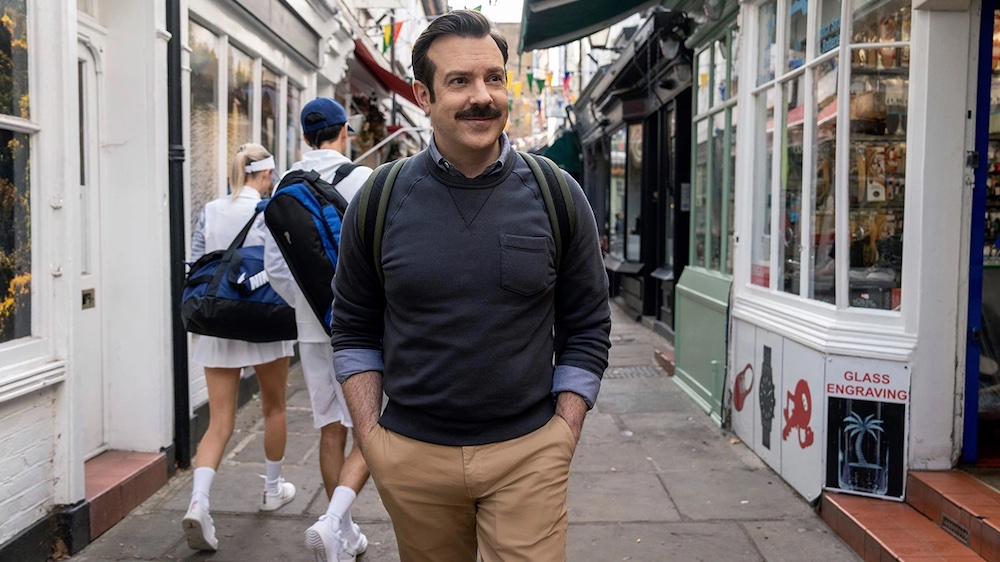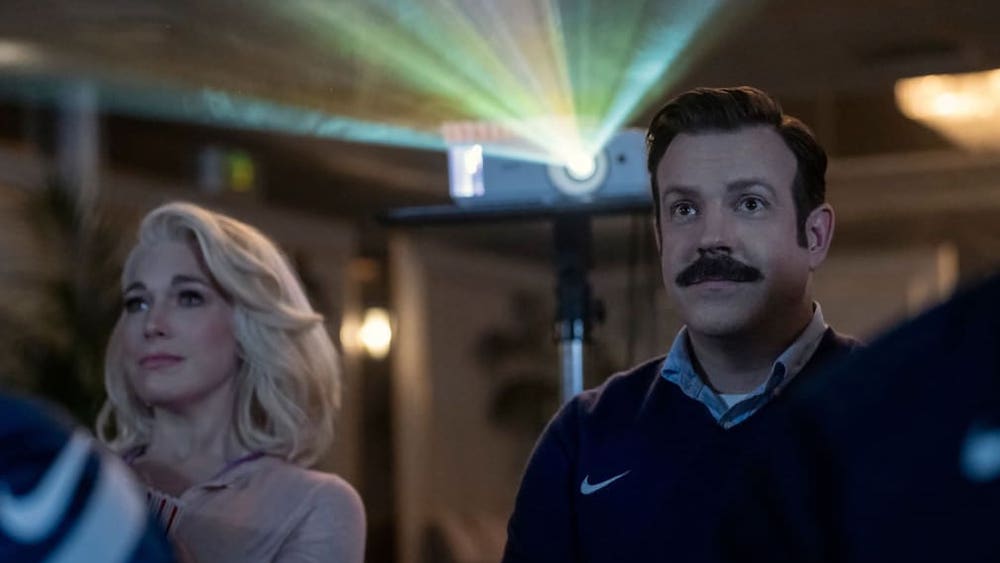
Among the twenty-one Emmy nominations received by Apple TV+ juggernaut Ted Lasso for its third and all-but-confirmed final season is its first mention for special visual effects in a single episode. The football-centric comedy competes in that category against Five Days at Memorial and a slate of fantasy series: The Nevers, Shadow and Bone, The Umbrella Academy, and Wednesday.
Below the Line had the chance to speak with VFX supervisor and first-time Emmy nominee James MacLachlan about the challenges and rewards of invisible effects, and specifically how he worked with series cocreator and star Brendan Hunt to determine how best to make their shooting locations look like the places where the show’s football team would actually play in real life.
MacLachlan broke down the scope of the show’s penultimate episode, Mom City, which is honored with this year’s VFX Emmy nomination, and his experience working with new technology and collaborating with an international team, including Americans who occasionally missed the nuance of certain British sports traditions.

BTL: I think this is the kind of show where most people who are not familiar with how visual effects work and the subtlety of them would say, “There are visual effects in Ted Lasso?” Do you get that question a lot from anybody who finds out what you’re doing?
MacLachlan: Yeah, it’s quite interesting. A lot of the visual effects are essentially invisible. It came down to a few things, but predominantly, have you ever met a groundsman from a Premier League football club? Have you ever met one? They’re interesting characters. They’re lovely people, and they are experts at grass on pitches, and what they don’t know isn’t worth knowing. I would suggest that they love their pitches almost as much as they love their friends and family, and they’re not really receptive to a film crew of two hundred people and some actors running all over their beautiful pristine pitches. So paramount, for this episode, for 11, was to create realistic-looking Premier League football gameplay shot in a field at a semi-pro club out in West London, and then augmenting every single shot throughout the entire show to make it look like we were playing in Premier League grounds.
The Emmy is up for the single episode for 3.11, where it was Manchester City’s ground, the Etihad Stadium, which is up in Manchester. Again, were dealing with multiple locations at multiple times and augmenting them all together. Aside from being able to be as free as we could with the cameras on the pitch, we had to make sure that obviously the narrative was serviced, what Jason [Sudeikis] and Brendan and the writers were all putting on the page had to be accentuated by the visual effects.
You’ve obviously got the foreground action, but what the crowds are doing in the background, what the stadium is doing, is actually paramount to the storytelling, because the actors themselves on the pitch, excellent footballers, the lot of them, the atmosphere mostly comes from the crowds, and the surging throngs of people around them. It was a nice thing to be able to augment the shots and create the vision for what was required around the players to lift the emotion in the scenes. So that was what was really appealing about it all.
There are 258 shots we turned over for one episode, for episode 11. A fair amount of it was working out how to make it look photoreal, but then, also service all of the narrative and make sure that crowds aren’t just all waving their hands and going crazy the entire match. You have to mimic what a real crowd would do. There’s highs, there’s lows. The emotion drives what’s happening in the foreground.

BTL: Would you say that that episode was, out of the two seasons you did, the most ambitious and challenging?
MacLachlan: Reading it, yeah, it was ambitious. We knew when we read the scripts nice and early, what we were going to have to achieve, but the shows were fairly successful through season one, and it took off and then season two, and you know how it goes. Each season it has to be a little bit bigger and a little bit better and a little bit more ambitious.
When we were doing page reads, we worked out fairly early that the page count on the visual effects was going to be significant for that episode. We’d also put a few things in place through the previous seasons so we had an understanding as to how we would shoot it and then post it. But we also wanted to make sure that there weren’t too many restrictions placed on certain people, like the actors or the DOP or the directors.
We were all, on the visual effects side, fairly open to giving them the freedom of movement. That meant new camera positions. That meant new styles of shooting. That meant pushing the boundaries on all fronts. So we knew we were going to have to raise our game again and again, no pun intended, to service what they what they needed.
BTL: Is there anything that you wanted to do either for that episode or another that proved to be too challenging and you had to pivot?
MacLachlan: No, but I would say, because we were so deep into the Ted Lasso process, so many people have been with us the whole way through, it’s that kind of show where everybody loved it so much, loved working on it. We were all super experienced by the second-to-last episode, so it reached the point where we knew there were things that we were going to push the boundaries with, so we had to be relatively flexible with some new techniques. One of the new techniques we used on this episode was getting Metastage involved. We had crowds of people, and we had to fill the stadium, but we were really conscious that we didn’t want to fill the stadium with digital people that were being just driven by data.
What we wanted to do was, in every instance, film people, have people interacting with real emotions and real feelings about what was going on within the match, and make sure that that was conveyed, because you fairly quickly realize if you’re watching a crowd how they interact with one another and what’s happening in the foreground is paramount. Shooting with Metastage, the advantage was, we captured them as a volume.
In the way that it’s shot, similar to a digital, traditional shoot with a camera, this stage captured the people as a volume, so we were able to place them in the stadium, which we used in multiple shots and relight them. They were a 3D volume, a 3D object, but they were a genuine, real person, giving real acting in a real stage offset and then they were placed into Etihad Stadium. That really pushed the boat out, which was a lot of fun to be involved with. We also shot sprites, so we also had people shot the semi-traditional way, with a camera, which we used on cards further back in the in the distance. But when they got really close to camera, we knew we were going to have to push the boat out, which is where middle stage really helped us.
We had a LiDAR team as well, who were exceptional, Visualskies, who we sent to Manchester for a couple of days, and so they had aerial and terrestrial LiDAR and photography and they scanned the entire stadium. These places, they’re not small. They scan them all to nut-and-bolt detail, which also enabled us to recreate in CGI and understand where we were in the stadium when we were shooting on a field in in London, understand where we were in the stadium, what we were doing, how we were placed, and how we could add extra detail into this stadium once it was finally rendered.
The combination of those things in conjunction with the fact that the great British weather, you never really know where the sun’s going to be, enabled us to relight scenes and have that integration in a way that, in the past, we haven’t necessarily had that flexibility. We knew because of the scale we were going to have to have that flexibility towards the end.

BTL: It’s obviously a very popular show and I assume that, unlike me, there are sports fans who are watching and looking for the details that you’re attempting to recreate. Have you seen anyone either complimenting or complaining about your detailed work?
MacLachlan: It pays not to go on the Internet and read comments, mate. You’ll go down a rabbit hole there. No, it’s wonderful. Jason is very good at football. Brendan Hunt, what he doesn’t know about football isn’t worth knowing.
BTL: Yes, I’ve heard from Brendan and others that he’s the only one who actually cares so much about football.
MacLachlan: Oh my god, he cares. We had extensive chats with the second unit football director, Pedro. Between the three of us, just leeching as much as we could out of Brendan and making sure we had all of the information and we were getting it as correct as we could at every moment. What was very fascinating outside of the core group of people who were the football nerds was the difference between American sports and British sports.
American artists at Barnstorm were putting the shot together, and they didn’t realize you can’t mix the crowds in the United Kingdom. There’s a real rivalry between teams. There’s a hatred, so they have sections where you put the away team and sections where you put the home team and they in no way ever mix. Every now and then, a render would pop out where an artist was new to the show or what have you, and they didn’t know these rules. So that was a funny and interesting one to come across and chat with the guys over in America.
But Brendan was all over everything. It was amazing, him and Pedro had all things covered. There’s very little that slipped through, and if it slipped through, it was definitely an anomaly. There’s always a pixel somewhere that fell off the render farm in an odd way. It was pretty exciting to see the level of enthusiasm that people gained in the football whilst shooting, even people who weren’t that interested in football. By the end of the Ted Lasso shoot, we shot in multiple blocks, even they were getting on board. It was amazing to watch the players. They’re exceptional.
One little anecdote, I don’t know if we’re allowed to talk about it, but, it’s never shown in the show, there is a full table, a final table of what happens, and we had to calculate that based on points and play and everything through the entire show. That was all built out, and Brendan was really keen to never give that all away, because he said it’s not necessary to determine what was happening in other parts of the table. It was important to know what Richmond was doing and he said that was for the Internet, but that he didn’t want to show the whole table. That was quite nice, because it gave us a little bit of wiggle room in post.
BTL: Your Emmy category feature a really interesting bunch of shows. Ted Lasso sticks out. Five Days at Memorial is the only one with very heavy effects work but no superpowered individuals like the other four. Have you seen any of your fellow nominees’ work?
MacLachlan: I’ve watched all of the VFX breakdowns I can find. The other nominees’ work, it’s all exceptional. I’m just finding this experience very surreal. It’s a bit like a dream for me. The one that really stood out for me was Five Days at Memorial. I really like the look of that one. It’s quite exceptional, what the guys have done. It just looks beautifully crafted. It’s really nice. It’s a little bit weird. I can’t believe I’ve been placed in rooms with these people and categories. It’s a bit surreal, but I’m sure it’ll sink in eventually.
BTL: I think it’s a big win for invisible effects! Do you prefer doing this kind of thing, bringing reality to life rather than something that will very clearly make audiences say, oh, “This is something that couldn’t happen, that had to be created this way?”
MacLachlan: I really like a mix. I can definitely appreciate the invisible effects. One hundred percent. It’s a craft, and it’s an art, and it’s a beautiful science, but I also like the escapism involved in in some of the more surreal, otherworldly effects of the imagination that you can’t get in a camera. Essentially, it’s achieving what we can’t shoot. If somebody can imagine it, it’s great fun to be involved generating that film for anybody. You’ve got a load of writers doing exceptional work at the table and you just want to help them envisage that vision that they have in their head. Whether it’s hidden or fantasy, I don’t have a preference, I’ll be honest.
The Emmy-nominated third and final season of Ted Lasso is now available to stream.





